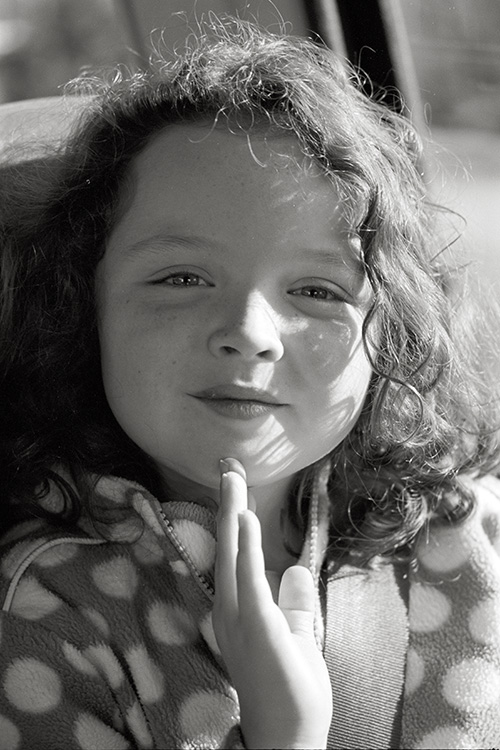singlespeed
Newbie
I scan b/w film as color positive, invert in P'shop and make curves adjustments, sharpening etc. as adjustment layers. Should I then convert to a greyscale file and print in colour, or keep the file rgb?
thanks.
thanks.
sojournerphoto
Veteran
I think that you can, normally, break down black and white film to digital workflow into distinct stages.
1. Acquire the image - scan either as positive or negative and invert as required. At this stage I will convert the image to monochrome using a black and white layer, but leaving the file as rgb (I tend to use sRGB colour space for monchrome, buit Adobe or Jo Holmes Dcam3 work well too). I may use levels to set black and whitepoints at this stage.
2. Do any general capture sharpening required - this can be difficult with high res scans of black and white film, so I use a range of strategies. For fast film photokit emphasises grain too much, so I use a high pass/hard light approach with very low opacity application.
3. Curves, dodge and burn as required (typically using masked curves which give good control over contrast too). Any local sharpening (very film dependent - Acros has low enough grain to be useable in this way)
4. Toning - again typically suing cureves layers at reduced opacity.
5. Print as RGB using suitable profile - Ilford Gold Fibre Silk is linear enough that I typically print Black and White using a relative colourimetric map.
So stick with RGB. If you want to print pure monochrome use the B&W mode on the printer if the profiles give you colour casts, otherwise print in rgb.
The image below had a bit of everything, plus some very limited highlight/shadows in PS. Everything on layers until it's finished at least.
Mike

1. Acquire the image - scan either as positive or negative and invert as required. At this stage I will convert the image to monochrome using a black and white layer, but leaving the file as rgb (I tend to use sRGB colour space for monchrome, buit Adobe or Jo Holmes Dcam3 work well too). I may use levels to set black and whitepoints at this stage.
2. Do any general capture sharpening required - this can be difficult with high res scans of black and white film, so I use a range of strategies. For fast film photokit emphasises grain too much, so I use a high pass/hard light approach with very low opacity application.
3. Curves, dodge and burn as required (typically using masked curves which give good control over contrast too). Any local sharpening (very film dependent - Acros has low enough grain to be useable in this way)
4. Toning - again typically suing cureves layers at reduced opacity.
5. Print as RGB using suitable profile - Ilford Gold Fibre Silk is linear enough that I typically print Black and White using a relative colourimetric map.
So stick with RGB. If you want to print pure monochrome use the B&W mode on the printer if the profiles give you colour casts, otherwise print in rgb.
The image below had a bit of everything, plus some very limited highlight/shadows in PS. Everything on layers until it's finished at least.
Mike

singlespeed
Newbie
thanks Mike, that's very helpful.
mfogiel
Veteran
I have tried once the to compare the B&W and RGB acquisition, and I have seen no gain in scanning in colour. The only case when this could be beneficial, is if you develop in staining developers. Also, scanning as positive is necessary only if the negative is too dense, this way you avoid clipping, but at the expense of some tone compression. In my experience, it is better to use compensating developers or simply develop shorter for a thinner negative, and scan as B&W negative. Also, I much prefer to use high acutance developers, as this removes the need for a grain enhancing sharpening in PS.
sojournerphoto
Veteran
I have tried once the to compare the B&W and RGB acquisition, and I have seen no gain in scanning in colour. The only case when this could be beneficial, is if you develop in staining developers. Also, scanning as positive is necessary only if the negative is too dense, this way you avoid clipping, but at the expense of some tone compression. In my experience, it is better to use compensating developers or simply develop shorter for a thinner negative, and scan as B&W negative. Also, I much prefer to use high acutance developers, as this removes the need for a grain enhancing sharpening in PS.
Agree, don't overdevelop and I scan as a negative in my Nikon. I stick with RGB as that allows me to tone easily and controlably.
I've just moved from Rodinal to Xtol for most film, as whilst I lie the tonality of Rodinal it does emphasise grain in a lot of films.
Mike
charjohncarter
Veteran
I don't print my files at home. I like Costco better. They do wet printing of digital files. I have found that sending them via internet even with all auto-correction turned off there is a slight brown cast. If I take them to Costco on CD and have them printed from that; no cast. But they are slightly lighter so I usually use the brightness/contrast slider to make them very very slightly darker. Sometimes I do two versions of each file to see which one I like the best. You can have the file name printed on the back to tell the difference.
Share:
